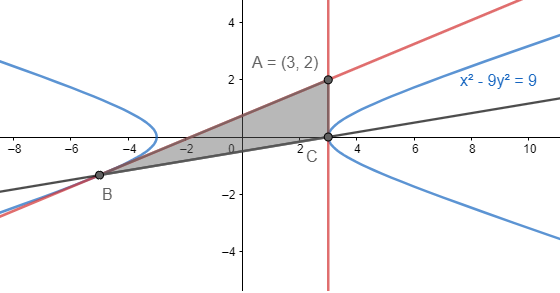
The area of triangle formed by the tangents from point (3,2) to hyperbola ${{x}^{2}}-9{{y}^{2}}=9$ and the chord of contact w.r.t. point (3,2) is :
Answer
584.4k+ views
Hint: Start by finding the equation of the chord of contact followed by the points where the chord of contact meets the hyperbola. Now once you know the points, you know all the three vertices of the triangle, so use the formula of area of the triangle with given vertices to get the answer.
Complete step by step solution:
First let us write the equation of hyperbola in standard form. On doing so, we get
${{x}^{2}}-9{{y}^{2}}=9$
$\Rightarrow \dfrac{{{x}^{2}}}{9}-{{y}^{2}}=1$
Let us start by drawing a representative diagram of the situation given in the figure.

Now we know that one of the vertices of the triangle is (3,2). We also know that the chord of contact to the hyperbola $\dfrac{{{x}^{2}}}{{{a}^{2}}}-\dfrac{{{y}^{2}}}{{{b}^{2}}}=1$ w.r.t. point (p,q) is given by $\dfrac{px}{{{a}^{2}}}-\dfrac{qy}{{{b}^{2}}}=1$ . So, the chord of contact given in the question is:
$\dfrac{3x}{9}-2y=1$
$\Rightarrow x=3\left( 2y+1 \right)............(i)$
Now, if we solve the equation of chord of contact with the equation of hyperbola, the points we get are the other two vertices of the triangle. So, substituting x from equation (i) in equation of hyperbola, we get
$\dfrac{9{{\left( 2y+1 \right)}^{2}}}{9}-{{y}^{2}}=1$
We know that ${{\left( a+b \right)}^{2}}={{a}^{2}}+{{b}^{2}}+2ab$ .
$4{{y}^{2}}+1+4y-{{y}^{2}}=1$
$\Rightarrow 3{{y}^{2}}+4y=0$
$\Rightarrow y\left( 3y+4 \right)=0$
So, the possible values of y are 0 and $-\dfrac{4}{3}$ .
If we put y=0 in equation (i), we get x=3. Also, if we put y to be $-\dfrac{4}{3}$ , we get x=-5.
So, the vertices of the triangle are (3,2), (3,0) and $\left( -5,-\dfrac{4}{3} \right)$ .
Now we know that the area of the triangle is equal to the absolute value of:
$\dfrac{1}{2}\left| \begin{matrix}
1 & {{x}_{1}} & {{y}_{1}} \\
1 & {{x}_{2}} & {{y}_{2}} \\
1 & {{x}_{3}} & {{y}_{3}} \\
\end{matrix} \right|=\dfrac{1}{2}\left| \begin{matrix}
1 & 3 & 2 \\
1 & 3 & 0 \\
1 & -5 & \dfrac{-4}{3} \\
\end{matrix} \right|=\dfrac{1}{2}\left( 1\left( -4-0 \right)-1\left( -4+10 \right)+1\left( 0-6 \right) \right)=-8$
So, the answer to the above question is 8sq units. Area is not to be negative and write it as |-8|.
Note: You could have also solved the questions by finding the tangents and the chord of contact, but that would be lengthy and complex to solve. Also, you need to learn all the formulas related to standard conic sections as they are used very often.
Complete step by step solution:
First let us write the equation of hyperbola in standard form. On doing so, we get
${{x}^{2}}-9{{y}^{2}}=9$
$\Rightarrow \dfrac{{{x}^{2}}}{9}-{{y}^{2}}=1$
Let us start by drawing a representative diagram of the situation given in the figure.

Now we know that one of the vertices of the triangle is (3,2). We also know that the chord of contact to the hyperbola $\dfrac{{{x}^{2}}}{{{a}^{2}}}-\dfrac{{{y}^{2}}}{{{b}^{2}}}=1$ w.r.t. point (p,q) is given by $\dfrac{px}{{{a}^{2}}}-\dfrac{qy}{{{b}^{2}}}=1$ . So, the chord of contact given in the question is:
$\dfrac{3x}{9}-2y=1$
$\Rightarrow x=3\left( 2y+1 \right)............(i)$
Now, if we solve the equation of chord of contact with the equation of hyperbola, the points we get are the other two vertices of the triangle. So, substituting x from equation (i) in equation of hyperbola, we get
$\dfrac{9{{\left( 2y+1 \right)}^{2}}}{9}-{{y}^{2}}=1$
We know that ${{\left( a+b \right)}^{2}}={{a}^{2}}+{{b}^{2}}+2ab$ .
$4{{y}^{2}}+1+4y-{{y}^{2}}=1$
$\Rightarrow 3{{y}^{2}}+4y=0$
$\Rightarrow y\left( 3y+4 \right)=0$
So, the possible values of y are 0 and $-\dfrac{4}{3}$ .
If we put y=0 in equation (i), we get x=3. Also, if we put y to be $-\dfrac{4}{3}$ , we get x=-5.
So, the vertices of the triangle are (3,2), (3,0) and $\left( -5,-\dfrac{4}{3} \right)$ .
Now we know that the area of the triangle is equal to the absolute value of:
$\dfrac{1}{2}\left| \begin{matrix}
1 & {{x}_{1}} & {{y}_{1}} \\
1 & {{x}_{2}} & {{y}_{2}} \\
1 & {{x}_{3}} & {{y}_{3}} \\
\end{matrix} \right|=\dfrac{1}{2}\left| \begin{matrix}
1 & 3 & 2 \\
1 & 3 & 0 \\
1 & -5 & \dfrac{-4}{3} \\
\end{matrix} \right|=\dfrac{1}{2}\left( 1\left( -4-0 \right)-1\left( -4+10 \right)+1\left( 0-6 \right) \right)=-8$
So, the answer to the above question is 8sq units. Area is not to be negative and write it as |-8|.
Note: You could have also solved the questions by finding the tangents and the chord of contact, but that would be lengthy and complex to solve. Also, you need to learn all the formulas related to standard conic sections as they are used very often.
Recently Updated Pages
Why are manures considered better than fertilizers class 11 biology CBSE

Find the coordinates of the midpoint of the line segment class 11 maths CBSE

Distinguish between static friction limiting friction class 11 physics CBSE

The Chairman of the constituent Assembly was A Jawaharlal class 11 social science CBSE

The first National Commission on Labour NCL submitted class 11 social science CBSE

Number of all subshell of n + l 7 is A 4 B 5 C 6 D class 11 chemistry CBSE

Trending doubts
What is meant by exothermic and endothermic reactions class 11 chemistry CBSE

10 examples of friction in our daily life

One Metric ton is equal to kg A 10000 B 1000 C 100 class 11 physics CBSE

1 Quintal is equal to a 110 kg b 10 kg c 100kg d 1000 class 11 physics CBSE

Difference Between Prokaryotic Cells and Eukaryotic Cells

What are Quantum numbers Explain the quantum number class 11 chemistry CBSE




